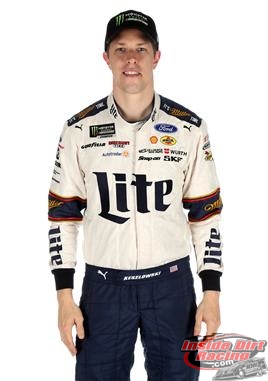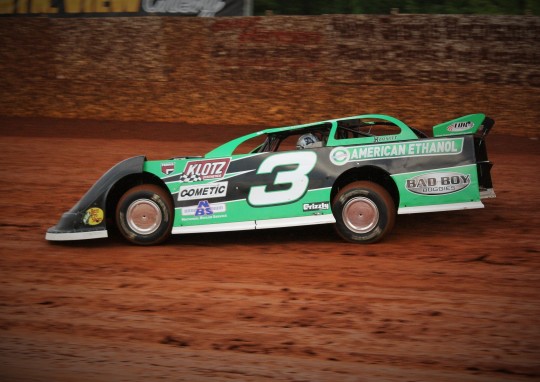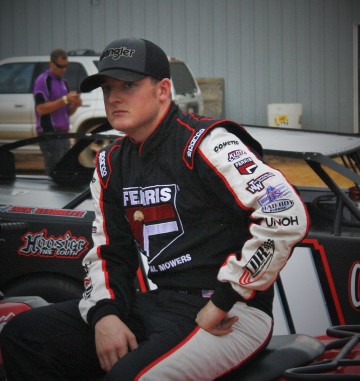Last Saturday Brad Keselowski drove to a third place finish in the ‘Zippo 200 at the Glen’ NASCAR Xfinity Series event at Watkins Glen International. While that may not seem particularly noteworthy, it is worth pointing out that because of new rules soon to be put in place by NASCAR, there will be fewer opportunities for Monster Energy NASCAR Cup Series regulars such as the Penske Racing driver to compete in such races in the future.
The stock car sanctioning body announced recently that beginning with the 2018 season Cup regulars such as Keselowski will be limited to no more than seven Xfinity Series and five Camping World Truck Series starts. Those numbers had been ten and seven respectively for this season.
Following the Xfinity race at Watkins Glen, Keselowski participated in the customary post-race press conference set aside for the top-3 finishers in NASCAR races. During that question and answer session with reporters, the 2012 Monster Energy NASCAR Cup Series champion made an interesting statement.
As reported by NASCAR writer Jeff Gluck of JeffGluck.com, the 33-year-old racer proposed that since he is not wanted by NASCAR (and presumably by Xfinity regulars) in that series, he should find some place else to race when not involved in Cup events. Bear in mind that, according to Gluck’s tweet, the comment was made somewhat in jest.
The @jeff_gluck Twitter post stated, Says @keselowski of running Xfinity next year (joking): “I might just go run some local tracks next year where people want me to run.”
Whether this statement was made jokingly or not, it is a great idea proposed by Keselowski. There are numerous potential benefits that could come of such a thing.
The benefit NASCAR is seeking for its two national touring “support” divisions is that they develop identities of their own. It’s hard to justify using the slogan “Names Are Made Here” when the drivers trying to make names for themselves are so frequently beaten by drivers who already have significant name recognition.
Regular competitors in both the Xfinity Series and the Camping World Truck Series face an uphill battle when they not only have to take on the experience and talent of Cup drivers but also the advantages provided by well funded and technologically superior teams such as Joe Gibbs Racing, Penske Racing, and Richard Childress Racing. At least reducing the number of starts allowed in these two series by Cup drivers takes one part of that double threat out of the mix.
But perhaps even more significant than the benefits for the two NASCAR series would be the good fortune received by those at the lower levels of racing. Tracks, series, competitors, and fans would all see increases in exposure and more.
I have covered numerous races that have had NASCAR stars participate on local tracks. In virtually every instance, track attendance increased as a result of that driver’s appearance. Whether those extra fans are regular attenders at short tracks or NASCAR fans just wanting to see their favorites in a new environment, it helps the track to have them come through the gate. And in these times in which many short tracks are struggling financially, every additional dollar helps.
For example, I once had a track official tell me that even just a rumor that a NASCAR driver might be on hand only to watch a race at that particular track causes a significant increase in sales of the more expensive pit passes.
Also, NASCAR drivers on the scene of a local track increases exposure for the track, the series, and the other competitors. Often times the more high-profile racers attract television cameras, writers, photographers, and websites that typically only report on NASCAR. That means your local track might be mentioned on a pre-race show and a major website or other publication. More exposure is rarely a bad thing.
Another possible outcome from Keselowski’s off-handed suggestion could be an improved relationship between NASCAR and other forms of racing. For whatever reason, fans of “grass roots” racing, particularly dirt racing, seem to be biased against NASCAR. Having the stars from that form of the sport might help patch whatever differences that exist between the two which could result in better attendance and increased television viewership for NASCAR.
And if nothing else, as Kyle Larson pointed out several weeks ago, showing up at local tracks can allow NASCAR drivers to sell more T-shirts with a greater return on investment than at a NASCAR track.
NASCAR racers such as Clint Bowyer, Tony Stewart, Kasey Kahne, Bobby Labonte, Kenny Wallace, Kyle Busch and Kyle Larson are among the NASCAR personalities who already have a vested interest in “grass roots” racing. Each of these listed above participate in other forms of racing as drivers, team owners, track owners, or car builders.
I can personally attest to the attraction of NASCAR stars at local tracks.
As a kid, my dad and I used to frequent places such as Atomic Speedway, Smoky Mountain Speedway, Newport Speedway and 411 Motor Speedway in east Tennessee. However, as I got a career of my own as a teacher and basketball coach my racing attendance at local tracks suffered. It was only after I took a job writing a weekly NASCAR column for a local newspaper that I once again visited a short track in 2008 after it had been announced that then Daytona 500 champion Ryan Newman would be racing at Volunteer Speedway in Bulls Gap, Tenn. I decided to cover that event because I thought it would provide a good angle for a story with a NASCAR star racing on a local dirt track. After that night, my interest in that form of the sport was rekindled and I have since been to hundreds of dirt races.
Perhaps more stories like that could be created if more NASCAR drivers raced on weekly short tracks. It could potentially do both parts of the sport a lot of good.
Keselowski’s comment may have been made in jest, but it could seriously lead to a number of benefits for more than one form of racing.








